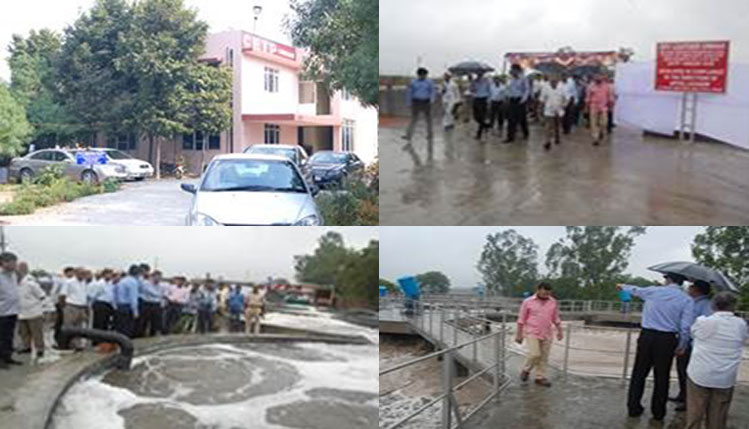Salient Features
This company was constituted under section (U/S) 25 of Co’s act 1956 of Govt. of India. As per the scheme of Ministry of Environment & Forests, Govt. of India, the company setup a Common Effluent Treatment Plant (CETP) with the assistance of World Bank and with the finanical grant of Central & State Government. In this project industry also contributed 20% of the project cost.The plant was commissioned in October 1995 and since then it is performing successfully around the clock and achieving the desired standards of treated effluent as per the prescribed norms of U.P.Pollution Control Board. It would not be out of place to mention here that the performance of CETP-Unnao has been an example for the others in the state.This plant has also been audited by United Nations Industrial Development Organization (UNIDO) and provided substantial technological supports including various sophisticated monitoring equipments.UNIDO has appreciated the CETP Unnao in writing. Not only this, Central Pollution Control Board has also monitored our plant several times in comprehensive manner and appreciated our continued efforts of pollution control for the concerned tanning industries.This plant has also beendeeply assessed and admired by various other international and national institutions so far.
The project Manager of this plant Dr.S.Awasthi has got several Honours/Award from Jounalist association of Unnao/U.P. and Hiralal Bajpai Paryavaran award and various others for excellent performance of CETP Unnao.
Designed Capacity of CETP:-
2.15 MLD. Upgraded Module of 2.35 MLD installed under IIUS of Govt of India in October 2013 and is under operation at full load as per directions of UPPCB to ensure treated effluent well within the prescribed norms of UPPCB. As per policy of CETP’s Board, no production capacities are increased by any member unit and the upgraded module is only serving in series to additionally treat the effluent from its old module and adequately handle the peak loads if any sometimes or maintenance in the old module.
Project cost for Upgraded Module of CETP Commissioned in October 2013 as per direction sof UPPCB: Rs.1.75 crores from industry contribution & Rs 3.25 crores from DIPP,GOI under IIUS assistance CETP Company has also submitted a project proposal for of salt water (Soak Liquor Effluent) segregation in the concerned member tanneries & common treatment at CETP, to Govt. of India through its consultant Dr.S.Rajamani,-Ex-CLRI Chennai for in principle approval, so that DPR could be submitted to UPPCB & MoEF for consent/ approval.
Introductory:
The CETP Unnao is environed in an area of 20000 sq.m. and connecting to its member units through an underground network of conveyance system. All the member units are also having their PETPs adequate to treat their wastewater primarily up to the standards prescribed by U.P. State Pollution Control Board Lucknow and also as per one of the conditions of Agreement with the member units for membership into the CETP.Technical Resume:
The plant is receiving the primarily treated wastewater continuously from the member units and keeps on pumping and treating it at the rate of about 80 –100KL/hour. For throttling purpose the plant is also equipped with some small pumps to meat out the steady rate of metabolic process at ASP system during holidays or weakly off days of industries. The Plant is based on ASP technology and comprising a physico-chemical treatment stage before letting the waste water into a set of two stage aeration system comprised with individual secondary clarifiers. At physico-chemical treatment stage we reduce around 35%-40% of BOD loadings and up to 90%SS. There after the 1st stage of aeration reduces the soluble substrate contributing the basic part of BOD up to 60% easily and 70-75% ideally. The supernatant there after reaches to 1st stage of secondary clarifier where solid liquid separation takes place and the solids are wasted/recycled into aeration based on metabolic process demand and F/M ratio. In the same manner secondary aeration system performs and continuous recycling of bio-sludge from second stage of clarifier is maintained and excess sludge is wasted into the beds to maintain F/M ratio and sludge as required. The resultant effluent bears normally following characteristics:PH---7.3 to 7.5
SS---60 to 90mg/l
BOD-20 to 29 mg/l
COD- generally range to 200 to 240 mg/l
Cr-III—0.32 to (BDL)
Basic Design of CETP(Name/Nos. of treatment Units): CETP treatment system based on two stage aerobic ASP system comprises following units-
Both the modules of CETP under operation in series are having:
Bar screen chamber and flow regulatory system: 1noEqualization/Holding Tanks: 2nos. (12 hrs DT each) with gentle mixing system
Clariflocculation Tank: 1no.
Primary Aeration System: 1no. (24 hr. HDT} with 4 Aerators/20 HP each& Oc 4days
Ist Stage Secondary Clarifier: 1no (3 hr. DT)
Second Stage Aeration System: 1no. (24 hr. HDT) & Oc 17 to 20 days
2nd Stage Secondary Clarifier: 1no (2.5 hr. HDT) SDBs: 28 no.
Final Outlet Point having online flow measuring arrangement: single-point outlet into Loni Drain
Hazardous Waste Handling & Management:
every member unit is operating Chrome Recovery Plant and therefore Cr-III concentration in the sludge remains quite down in the range of 1g/kg (dry sludge) that is well within the limits of amended Hazardous Waste Management & Handling Rules. However we are adopting safe methods of storage of solid waste as guided by U.P. Pollution Control Board & CPCB. The final disposal of this hazardous waste is being done into Secured Landfill Facility at UPSIDC Leather Technology Park Banthar, Unnao through SPV IIS (India) which developed this project under IIUS of Govt. of India in October 2008. For the compliance of Hazardous waste Rules 1989 the following arrangements are the pride of our company as mentioned inTechnical Performance at a Glance
